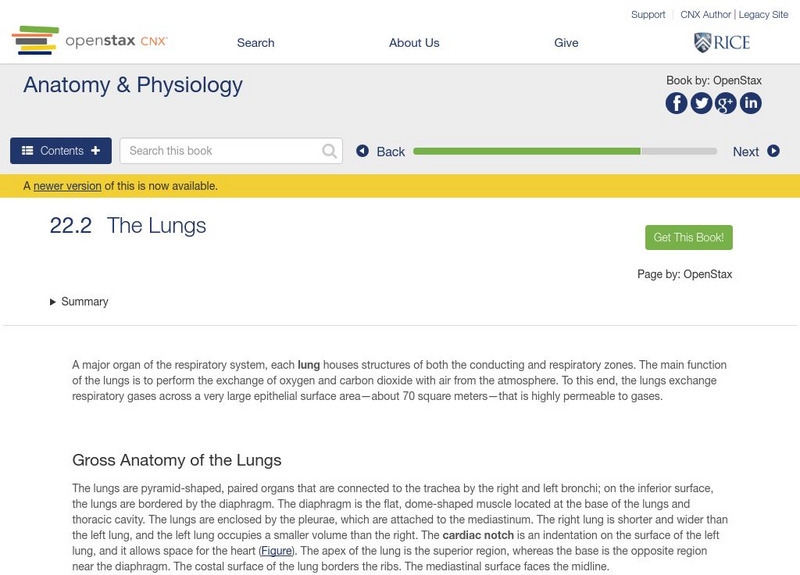Hi, what do you want to do?
Curated OER
Asthma
Students experience what it feels like to strain for air in order to empathize with people who have asthma. They create a simple model of the respiratory system to measure the effect of narrowed airway channels.
Curated OER
Amphibians
In this amphibian learning exercise, students read about the frog life cycle to complete the Venn diagram. They also answer 16 fill in the blank questions about frogs.
Curated OER
Fearsome Creatures 1
In this wild animals worksheet, students fill in the blanks or choose the correct words to sentences about wild animals. Students complete 47 blanks.
Curated OER
Animals Must Fit In
A instructional activity on tadpoles is here for your young biologists. Learners read a short paragraph on tadpoles, then answer three questions regarding how parts of their bodies help the tadpole to survive in the pond. There is a good...
Read Works
Trading Pumpkins
Can you imagine a pumpkin patch without pumpkins? Learners read how Tammy's family solves their problem in a cooperative way, followed by a set of 10 reading comprehension questions.
Curated OER
Sea Turtle Vocabulary
In this sea turtle vocabulary skills worksheet, students match the 9 listed sea turtle-related terms to the appropriate sentences that describe each of them.
Curated OER
Sea Turtle Challenge
In this sea turtles activity, students read 9 definitions that pertain to words about sea turtles. From four choices, students select the word that best matches each meaning.
Curated OER
Anatomy Review
In this biology worksheet, students examine the internal functions of the human body while considering the factors needed to explain the physiological reactions.
Curated OER
How to Make a Model of the Human Respiratory System
Students label parts of the human respiratory system on a diagram. They explain the function of diaphragm.
Curated OER
Health Education: First Aid
Fourth graders come to the aid of others. In this personal health lesson plan, 4th graders acquire the skills for providing first aid for choking victims, including demonstrating the Heimlich maneuver.
Curated OER
Seashell Homes
Pupils listen to a story about seashells. They discuss shelled animals. Learners describe the function of seashell. Pupils relate the function of a seashell to their own dwelling. They differentiate between shelled animals that make...
Curated OER
Arthropods
In this arthropods worksheet, students review the characteristics of arthropods by choosing from 15 terms to fill in the blank of 10 statements.
Curated OER
The Weight of Water
Students examine how salt water is more dense than fresh water through experimentation with eggs.
Curated OER
Animal Classification
Students classify animals. In this animal classification lesson plan, students identify characteristics from each of the 5 categories of vertebrates. Students group animals by categories.
Curated OER
Respiratory System
In this crossword puzzle worksheet, students answer 16 clues about vocabulary related to the human respiratory system. Clues list number of letters for correct word.
Curated OER
Respiratory System Crossword Puzzle Answers
In this crossword puzzle activity, students are provided with the answers for 16 clues about vocabulary related to the human respiratory system.
Curated OER
Humans
In this anatomy instructional activity, students read a passage about the different parts of the human body. They then answer the 10 questions on the page.
Curated OER
Phrasal Verbs Quiz: Mixed 4
In this phrasal verbs worksheet, students check their understanding of English phrasal verbs by choosing the best ending for each sentence.
Curated OER
Explorit's Fishy Quiz
In this online interactive fish quiz worksheet, students respond to 6 questions about fish. Students may check their answers for accuracy.
National Institutes of Health
National Heart, Lung and Blood Institute: What Are the Lungs?
Find excellent information about the human lungs, and how they contribute to the gas exchange process for the body. Inside, find detailed illustrations and a short, narrated animation of the respiratory system at work.
OpenStax
Open Stax: Anatomy & Physiology: The Lungs
Students learn the overall function of the human lungs, and then summarize the blood flow pattern associated with the lungs.
Other
Canadian Lung Association: Lung Disease Statistics
Get the statistics on lung disease in Canada. In addition to more general facts and figures, you will find links to reports on specific lung-related conditions such as: asthma, emphysema and chronic bronchitis, influenza, and tuberculosis.
TeachEngineering
Teach Engineering: Breathe In, Breathe Out
Students are introduced to the respiratory system, the lungs and air. They learn about how the lungs and diaphragm work, how air pollution affects lungs and respiratory functions, some widespread respiratory problems, and how engineers...




























